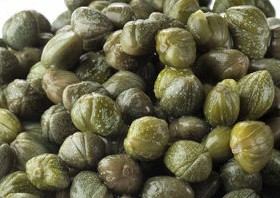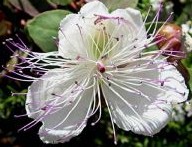 Caper is a broad leaf evergreen creeping shrub native to the Mediterranean, East Africa, Madagascar, parts of Asia, Himalayas, the Pacific Islands, Indomalaya, and Australia where it grows on lean, dry, rocky soils in full sun. The plants grow to two to five feet high and three to eight feet wide. They produce round to ovoid, thick leaves that are dark green, are up to two inches long and has spines on the petioles. The fragrant white flowers are borne on long pedicils and are two to three inches across. They have long purple stamens and only last a single day but are produced over a long bloom time from spring until fall. The fruits that follow are called caperberries. The condiment that we know as capers are the flower buds which are pickled or salted, but the caperberries and are also preserved and used in cooking, although they are considered less tasty.
Caper is a broad leaf evergreen creeping shrub native to the Mediterranean, East Africa, Madagascar, parts of Asia, Himalayas, the Pacific Islands, Indomalaya, and Australia where it grows on lean, dry, rocky soils in full sun. The plants grow to two to five feet high and three to eight feet wide. They produce round to ovoid, thick leaves that are dark green, are up to two inches long and has spines on the petioles. The fragrant white flowers are borne on long pedicils and are two to three inches across. They have long purple stamens and only last a single day but are produced over a long bloom time from spring until fall. The fruits that follow are called caperberries. The condiment that we know as capers are the flower buds which are pickled or salted, but the caperberries and are also preserved and used in cooking, although they are considered less tasty.
 The flower buds of the caper bush must be harvested in the morning when they are just the right size. They are put aside for a day to wilt and then put into a heavily salted wine vinegar where they develop their characteristic flavor that some experts say is goat-like, giving rise the to generic name Capperis from the Latin caper meaning billy-goat. The specific epithet, spinosa, is the Latin word for spine.
The flower buds of the caper bush must be harvested in the morning when they are just the right size. They are put aside for a day to wilt and then put into a heavily salted wine vinegar where they develop their characteristic flavor that some experts say is goat-like, giving rise the to generic name Capperis from the Latin caper meaning billy-goat. The specific epithet, spinosa, is the Latin word for spine.
The best capers come from France and are called Nonpereilles. They are the smallest kind of caper and the most expensive. Capers are delicious with strong-flavored oily fish and tomatoes. They are a key ingredient in Liptaur cheese and tartare sauce. Try them with smoked salmon, cream cheese, and dill for an memorable appetizer.